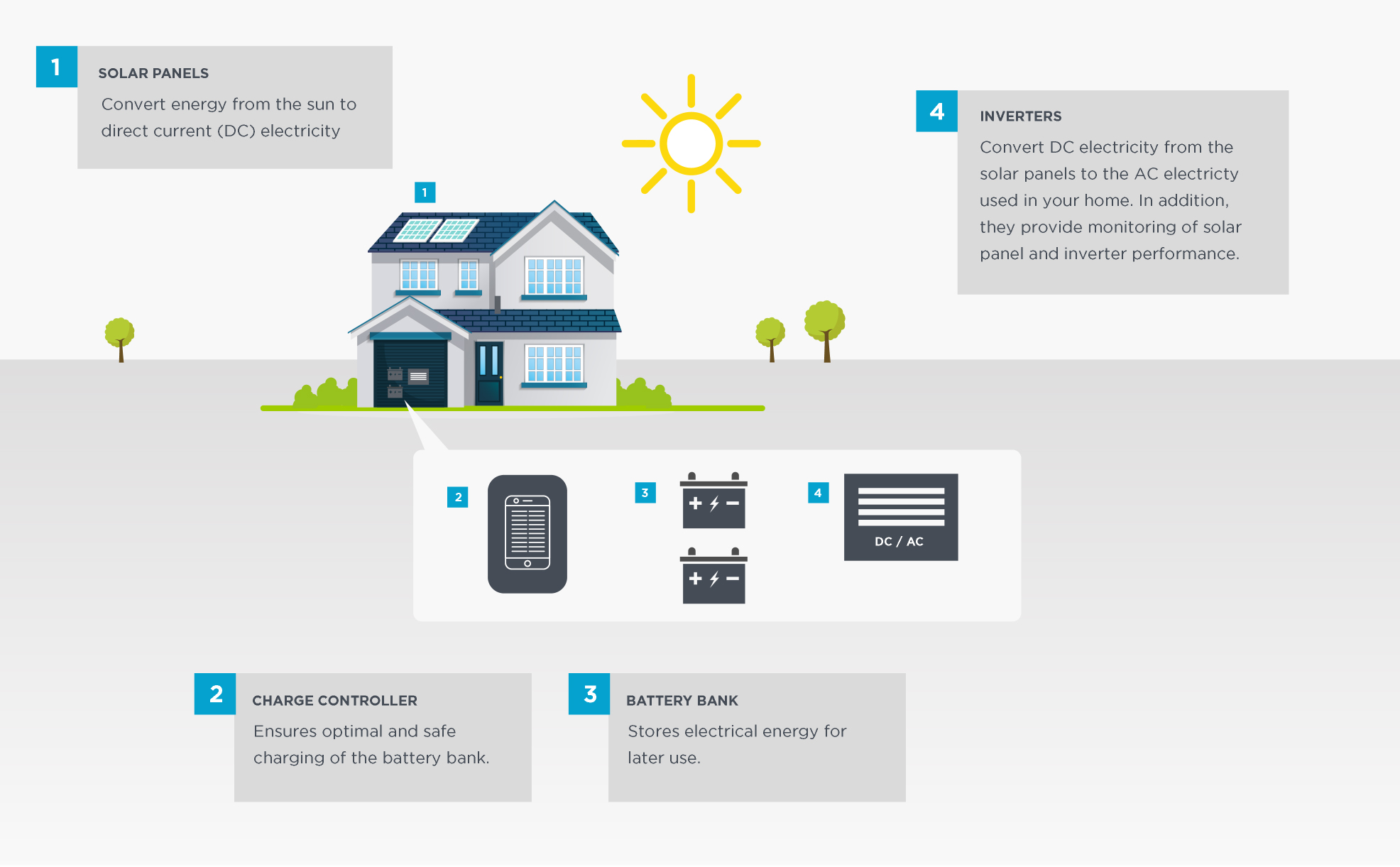Hybrid Solar Solution Explained – How does it actually work?
Whether for the small business, home owner of home business, the Hybrid Solution is your premium option to:
- Save on your electricity bill
- Avoid the inconvenience of load shedding or an unexpected power outage
- Become completely energy independent and energy efficient
- Invest in your future and that of the next generation by going green
- Protect your appliances and electronics against damage due to prolonged spikes in electricity, caused by load shedding and power outages
The Hybrid Solution consist of a collection of components to enable you to run a Solar Power System for your home or business, and includes the following:
- Solar panels
- A charge controller
- An inverter
- Battery / batteries
A solar panel is an aluminium or stainless steel frame. A “Photovoltaic Cell” inside the frame is protected by a thick and transparent sheet of protective glass. The cell converts photons that come directly from the sun and transforms it into electricity – this cell is the component that turns the sun’s UV rays into Direct Current (DC) energy.
Once the rays have been collected and converted into practical energy, it gets sent to an inverter which takes the flow of the energy through a transformation that entails switching it from DC energy to AC (Alternate Current) energy. It is the AC energy/electricity that is utilised in your home. The amount of panels you will require will depend on how many kilowatt hours (kWh) of electricity you use.
Ensures optimal and safe charging of the battery bank. Without the controller the system lacks stability. It is a vital element to the solar energy system to avoid the system from overloading.
The battery bank stores the excess electricity produced by the solar array which is not utilised by your appliances. It stores the energy for consumption either at night (when the panels are not generating any power), during inclement weather or when your load demand exceeds the power produced by the solar array. With a grid tied system, the system can automatically use the electricity from the grid (Eskom) in the event of both the solar panel and battery capacity not being sufficient. Despite having a battery bank it is recommended to remain tied to the grid in the event of a fault in your system, bad weather for an extended period of time, or if your load requirements cannot be supported by your solar system alone.
The inverter converts the sunlight (collected by the solar panels) from direct current (DC) electricity to alternating current (AC) which is the electricity used in your home. It further provides the monitoring of your solar panel and inverter performance.

In short, the solar panel array generates energy from the sun for electricity use during the day. The energy flow then gets sent to an inverter which enables the conversion from DC (direct current) into useable alternating current (AC). The inverter is set up to decide where electricity is required – sending the electricity to your essential appliances and/or your back-up battery bank. The batteries store all the excess energy generated by the solar panel array which is not utilized by your appliances. As a result, the batteries stores the energy for use, either at night (when the panels are not generating power) or during periods of inclement weather, or in the event of your load requirement exceeding the power generated by the panel array.
Due to the system being tied to the grid, it can automatically use the energy/electricity from the grid to make up for any shortfall (if both solar panel array and battery capacity are insufficient).
A hybrid solution enables you to both reduce the cost of your electricity consumption as well as avoid the effects of load shedding.
Why a hybrid solar system is tied to the grid:
Most systems are grid-tied, even if the system is sized large enough to not require the grid. A grid-tied system is merely a solar system connected to the electrical grid (utility power) and as a result, it uses electricity from both the solar panel system as well as the electrical grid.
It protects your system from being damaged in the event of a power surge due to an unexpected power outage or, if there is a prolonged period of inclement weather preventing your panels from generating electricity at their full capacity. Depending on the specific municipality, this solution can give you the option to feed back into the grid allowing your electricity bill to be credited.
JSGRP Hybrid Solution Packages:
We partner with only the best to give you the ultimate solution, and when it comes to advanced modelling, use only the latest and newest technology;
Our various Hybrid Packages consist of a Tier 1 Solar Panel, an Alpha ESS SMILE5 Hybrid Inverter, Charge Controller and an Alpha ESS SMILE5 Lithium Iron Phosphate Battery. The Smile 5 is the 3rd generation storage system developed independently by Alpha ESS. The sleek, classic design will compliment any room within your home. The name SMILE was derived from the 5 unique features and characteristics of the system:
With a Hybrid Solar Solution, there is no cost involved to produce energy – it is complimentary from the sun. We live in a country which has close to perfect climatic conditions for solar energy. As if that is not enough to SMILE about, this investment will pay for itself in an average of 5-7 years. We offer various Hybrid Packages, it all depends on your specific needs.
